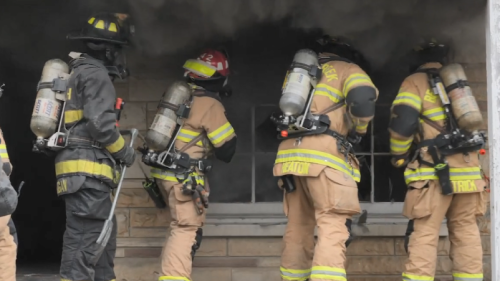One of the oldest tools in the structural firefighting toolbox is ventilation. We’ve learned all the relevant terms and techniques related to horizontal, vertical, negative and positive pressure, but let us not forget about one of the simplest forms of ventilation – hydraulic ventilation. Seasoned members probably remember this technique coming and going from our collective consciousness, but it’s always remained an option – one that requires no more equipment than the hoseline we already have on the scene.
Honing our craft
In our training, we learned to place a fog nozzle in an open window and flow it to help vent a space after we suppressed the fire. We practiced the technique and thought we understood why and how to apply this tool. But one thing has become clear: There has not always been a clear consensus on how these techniques work and when we should use them. After all, like many other topics in the fire service, ventilation techniques were often handed down based on stories and tradition rather than science.
As we now know so much more about ventilation through the rigorous research of groups like UL’s Fire Safety Research Institute, we can revisit and learn more about the techniques we have employed over the years and better understand the effect they have on the fire environment. Once we understand this, we can apply these tools more precisely and effectively.
Before we dive into the effect of hoselines and air entrainment, let’s lay some groundwork about how ventilation and fires work.
Fires and flow path
Fire is a gas-phase chemical reaction that generates hot, buoyant gases. When we heat air, it has more buoyancy, so it will begin to exert pressure on its container and try to flow to an area of lower pressure. In simple terms, fires heat air, and this air wants to move to areas of lower pressure. This flow path is important to understand. Fire is and always will be a pressure-driven phenomenon. When a fire burns, as long as it does not run out of fuel or oxygen, it will continue to produce hot, buoyant products of combustion that will try to move away from the fire and toward areas of lower pressure. This flow can spread the fire throughout a structure and threaten occupants and firefighters on arrival.
Ventilation means pressure change
When we talk about ventilation, no matter what kind of technique we use, we are, on a basic level, manipulating the pressure inside of the structure and in the fire environment. Open the roof and the ceiling in the fire room, and we relieve some pressure and attempt to prevent the fire from spreading. Stick a PPV fan in the door, and we overcome the pressure in the house and push the fire out of the window, limiting its spread.
It takes very little pressure to cause a flow path – or disrupt one. A common misconception when thinking about ventilation, especially positive pressure, is that you have to pressurize or fill the box you are ventilating. The house is already full of air, so rather than filling it up, we simply need to push on the air molecules that are already present. This pressure then gets evenly applied to the rest of the structure as long as there are no barriers, and will cause the air to start to flow to an area of lower pressure. This happens with pressures much less than a single pound per square inch.
Simple, right? Except in the real world, our ventilation also adds lots of fresh air, and fresh air has oxygen. In 1978, the fire probably already had all the oxygen it needed as it burned inside the old drafty house, consuming slower-burning furniture. Today, your fire is probably starved for oxygen, and the oxygen we introduce with ventilation can be just what it needs to roar back to life. This isn’t to say ventilation is bad, but there are times when we need to apply ventilation carefully. Most of us have learned this by now, and concepts like limiting door opening and taking into account the effect of wind have entered into our consciousness. Many times, using vertical ventilation or a PPV fan without understanding their impact means the fresh oxygen introduced allows for fire to grow and create additional pressure that will negate the ventilation efforts and worsen our problems.
Hoses most water … and air
What’s interesting is that we learned so many years ago to use our hoseline to move air during hydraulic ventilation. We never really understood that nothing magical happened when we flowed a hoseline out of a window but rather that the nozzle was doing what it did all along, dragging air along with the water flowing. This is called air entrainment. This air entrainment did many things inside of burning structures, like upsetting the thermal balance in a compartment fire, causing countless recruits (and their instructors) to get a little toasty in burn buildings.
Air entrainment caused the pressure in a compartment to increase when we packed it full of air during an improperly conducted exterior attack, leading many to believe that hoselines from the exterior would push fire all over the inside of the hose. Once we started measuring the ability of our hoselines to move air, we could start to understand why this phenomenon happened and the role our hoselines played. It also drove the age-old argument of fog nozzles vs. smoothbore nozzles.
In 2002, Jerry Knapp and others at the Rockland County (N.Y.) Fire Training Center measured how much air was moved while flowing various types of nozzles in an experiment set in a shipping container. It was one of the first times we had solid numbers of just how much air a nozzle could entrain, and it allowed comparisons of various types of nozzles. One discovery was that a smoothbore nozzle, and a fog nozzle set on straight stream moved virtually the same amount of air, and both flowed much less than the fog nozzle.
In 2016 and 2017, FSRI completed a research project titled Impact of Fire Attack Utilizing Interior and Exterior Streams on Firefighter Safety and Occupant Survival: Air Entrainment. This project compared types of nozzles and nozzle movement. We learned that narrow fog patterns move more air than wider ones, and when we flow, if we manipulate the stream by using an “O” pattern or “Z” pattern we will move more air than a nozzle held still. The project also saw flow rates nearly equaling what some PPV fans on the market today can flow. This was an eye-opener as far as just how much air we are moving, even when we aren’t intentionally performing hydraulic ventilation.
What does it all mean?
So, what does this mean regarding takeaways for us while we do our job of suppressing fires? There are a few things to consider:
- We move air when we flow a line: If we are flowing water, we’re moving air. This is a good thing inside a structure as we approach the fire, pushing cool moist air into the fire environment. This will cool and contract hot gases, making them less buoyant and reducing the pressure. This means the hot gases will be less likely to spread throughout the structure and reduce the chances of unburnt gases in a flow path from igniting and burning us. We don’t need to wait until we are at the seat of the fire to open a line; we can start flowing as soon as we can reach the fire with our hoselines. Some of the FSRI tests saw flow rates of nearly 10,000 CFM. Some of the newer PPV fans on the market will flow from 12,000 to 14,000 CFM. Flow rates were also higher when the straight stream was rapidly moved in an “O” pattern or otherwise “whipped.” This ends up entraining air similar to a fog stream.
- Straight stream and smoothbore both work: We can utilize a smoothbore nozzle or a fog nozzle on a straight stream when we are fighting a compartment fire. Either of these nozzle types can accomplish this mission without moving enough air to disturb thermal layering. If we start flowing a fog pattern, we will move more air and likely disturb the layering before the hot gases have been cooled.
- Exterior attack needs a straight stream: When we use an exterior attack to reset a fire, we can make the inside environment more tenable to occupants and firefighters. We can deliver water into the fire compartment by using a straight stream off of a window frame or lintel, and cool and contract gasses. Using a straight stream is important as we will deliver the most water with the least airflow. If we use a fog steam or whip our hoseline around, we will entrain air and pressurize the compartment. This can lead to hot gas and smoke being displaced and will be less effective than a straight stream directed at a single point with little movement.
- We’ll always have hydraulic ventilation: Once we have knocked down a fire, if we have a building opening, hydraulic ventilation can be a great tool to rapidly reduce the fire area’s temps and exhaust toxic smoke. Remember, though, that we need to flow a fog pattern through the window and have an inlet into the building. We will likely need to open the door or other openings to provide a supply of outside air to replace what we are pushing out of the window. Once the fire has been located and suppressed, and hydraulic ventilation is started, door control is less important, and we can open up and allow cool air in. Remember, any time we do ventilation, we manipulate pressures, and we must have an inlet and an exhaust point.
Final thoughts
Our hoselines are a powerful tool for many things, but the ability to move air is one we don’t always consider. Thinking in terms of delivering a burst of water and air when we flow a line can help us understand how the fire environment will react, and how we can get the most out of the tactics and techniques we use at our next fire.










